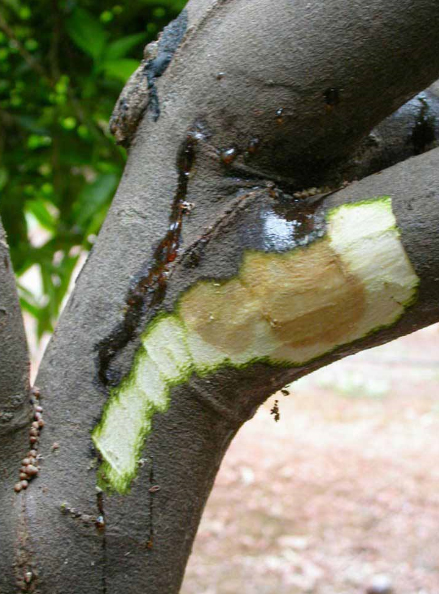 Phytophthora
Phytophthora
Scientific Name
[Water mold] Phytophthora spp.
Other common names
Phytophthora foot rot, root rot, brown rot, gummosis, and Phytophthera-Diaprepes (PD) complex
 Disease cycle
Disease cycle
Phytophthora is a water mold (Class Oomycetes, formerly a fungus-like protist) that is found throughout the world. Under favorable conditions (high moisture and temperature) it produces large numbers of motile zoospores that can swim in water for short distances. These zoospores are the infective agents that may be transported in rain or irrigation to the roots. When zoospores contact roots they encyst, germinate and enter the root tip resulting in rot of the entire rootlet.
Foot rot or gummosis occur when zoospores splash onto a wound or bark crack around the base of the trunk. Additionally, there is an association of Phytophthora root rot when roots are damaged by citrus root weevils, particularly Diaprepes abbreviatus. Root stock susceptibility depends on which Phytophthora species are present and the presence of favorable soil, water and environmental conditions.
Symptoms
Leaf - yellow foliage and shoot die-back. If citrus weevils are present adults may feed on leaves causing notching.
Fruit - reduced fruit size and yield.
Trunk - infection of the trunk by Phytophthora results in dark water soaked areas in the area of active infection. Lesions usually occur on the bark or at the bud union. Lesions may exude copious amount of gum and a brown necrotic area will be found under the bark lesions. Dead bark tends to break away from the trunk in vertical strips. Lesions may spread around the circumference of the trunk slowly girdling the tree.
Whole tree - Phytophthora may result in poor tree health, thin canopy, failure to make new growth, and little water and nutrient uptake leading to wilting. When roots are infected the surface of the root becomes soft, discolored and appears water-soaked. Fibrous roots slough their cortex leaving only the white thread-like root cylinder.
It should be noted that: Phytophthora root rot symptoms progress much more rapidly in the presence of the citrus root weevil.
Host range
Most scion cultivars are susceptible to bark infection, while most root stocks are moderately tolerant to bark infection. In ascending order, Cleopatra mandarin, Sour orange, rough lemon, Rangpur lime, Carrizo, Troyer are tolerant to root rot. Trifoliate, Swingle citrumelo, Yuman and alemow are considered highly resistant to bark infection and tolerant to root rot. Swingle citrumelo is the most tolerant rootstock. The presence of Diaprepes root weevils, Phytophthora palmivora and poorly drained soil can render normally tolerant Swingle citrimelo and Carrizo suseptible to Phytophthora root rot infection.
Distribution
Phytophthora spp. are found in citrus producing region around the world.
Easily confused with
Phytophthora bark infection can be easily confused with psorosis.
We currently serve - Mesa – Gilbert - Tempe - Chandler - Queen Creek - Scottsdale – Paradise Valley - East Phoenix Arizona.
